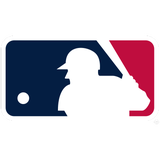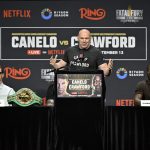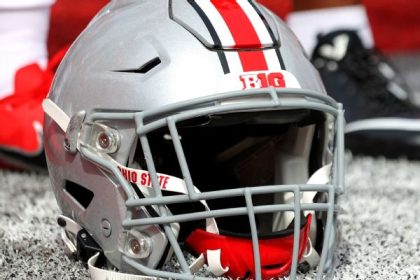How does Juan Soto fit on the New York Yankees‘ roster?
It’s a silly question, really. If a Ferrari shows up on your curb, you make room for it in the garage. If a new Le Creuset dutch oven gets delivered to your house, you make room for it in the cupboard. If Keanu Reeves wants to be best friends, you find time in your schedule to get dinner.
Soto is the same.
On Wednesday evening, the Yankees acquired Soto, 25, in the blockbuster trade of the winter, sending a cadre of pitchers and catcher Kyle Higashioka to the San Diego Padres in return for Soto and center fielder Trent Grisham. Soto is one of the best hitters in the world, a true monster who should immediately transform New York’s lineup. The prospect of facing Soto and Aaron Judge back-to-back must have American League East pitchers quivering in their boots.
ADVERTISEMENT
RELATED: Juan Soto trade analysis: Are the aggressive Yankees back? What’s next for Padres?; Why the Yankees still have work to do after trading for Juan Soto
But while Soto slides seamlessly into the Yankees’ batting order, he’s a slightly more defensive fit. The three-time All-Star is an offensive terror, a force to be reckoned with, but has recently devolved into a truly awful outfielder. According to Statcast’s Outs Above Average metric (OAA), Soto was the sixth-worst defensive outfielder in baseball this past season.
That alone would not be cause for concern, but seen alongside New York’s recent addition of Alex Verdugo, the Yankees outfield alignment looks somewhat suboptimal at first glance. Soto in left, Judge in center and Verdugo in right aren’t exactly a gold glove trio, raising questions about the team’s run prevention in 2024.
There was some speculation that Grisham might be the team’s regular center fielder, pushing Judge to a corner and Verdugo to a DH share with the oft-injured Giancarlo Stanton, but on a Thursday afternoon Zoom call with reporters, Yankees general manager Brian Cashman confirmed otherwise.
“If today was Opening Day, you know, Judge would be out in center field, by the current alignment that we have,” Cashman said.
The 2022 AL MVP first saw time in the outfield’s most demanding spot during the 2021 season. Judge started 21 games in center that summer before becoming the club’s regular center fielder for stretches of 2022 (74 starts). A toe injury this summer limited him to only 16 starts in center compared to 50 in right and 38 at designated hitter, but Cashman expressed to reporters that Judge’s toe won’t be an issue going forward.
“We think he’s fine. We think that’s resolved. We think that issue is behind him,” Cashman asserted.
When fully healthy in 2022, Judge graded out as a slightly above-average runner by Statcast’s sprint speed metric. While that technically made him one of the slowest center fielders in baseball that season, Judge’s enormous frame and long limbs allow for his relatively middling speed to play up. But speed isn’t everything and defensive metrics see Judge as a passable, if slightly below average, defensive center fielder. It’s reasonable to expect that late in close games, Judge would move over to a corner and Grisham, a spectacular glovesmith, would enter as a defensive replacement in center.
It’s also worth noting that Verdugo and Soto might switch from their traditional corners — Verdugo moving to left and Soto to right — given Yankee Stadium’s unique dimensions. Verdugo is a superior defender and there’s significantly more room out in left field in the Bronx.
Is that a mediocre to bad defensive outfield? Given Soto’s struggles with the glove and Judge being closer to decent than stellar, absolutely. But it’s undeniably worth it to get Soto’s bat and overall superstardom into pinstripes. And there’s a good chance that Soto might end up seeing a significant amount of time at designated hitter.
Stanton has missed significant time to injury every year since 2018. Even when he is “healthy,” he’s far from the athletic marvel he used to be. In 2023, there were times that Stanton was reduced to a brisk speed walk while running the bases. His availability is such a present concern to the Yankees front office that Cashman openly critiqued his $25 million-a-year slugger last month at the GM meetings.
“He’s injury-prone. We all have lived and known that, but he’s never not hit when he’s playing, and this year is the first time that’s happened,” Cashman told reporters. “”We try to limit the time he’s down. But I’m not gonna tell you he’s gonna play every game next year because he’s not. He’s going to wind up getting hurt again more likely than not because it seems to be part of his game.”
The Yankees GM echoed a similar, though more vague, sentiment after the Soto addition.
“But as to the opportunity it provides when you have a lot of depth, if we do have injuries that hit our roster, depending on who it is, no matter who it is, we’re in a better position now than we were maybe 48 hours ago,” Cashman said.
Stanton is not going to play 150 games in 2024. The Yankees know this. Whenever the gargantuan 34-year-old inevitably is sidelined, skipper Aaron Boone can simply move Soto to the designated hitter spot, bring Grisham off the bench into center and push Judge back to right. The Opening Day “ideal” lineup is never going to be the most common alignment. In a roundabout way, the Soto acquisition, a top-end roster add, also bolsters the Yankees’ depth in a pretty significant way.
Jake Mintz, the louder half of @CespedesBBQ is a baseball writer for FOX Sports. He played college baseball, poorly at first, then very well, very briefly. Jake lives in New York City where he coaches Little League and rides his bike, sometimes at the same time. Follow him on Twitter at @Jake_Mintz.
MLB trending

Get more from Major League Baseball Follow your favorites to get information about games, news and more












